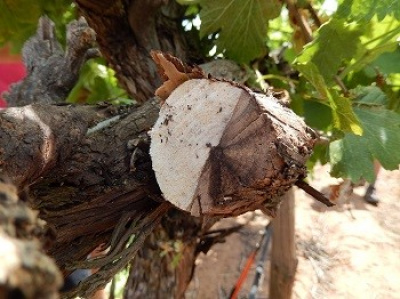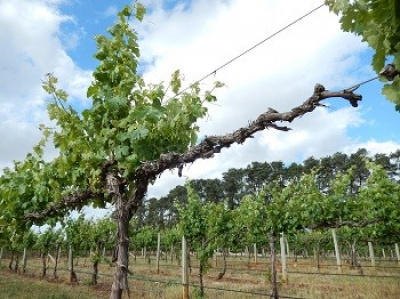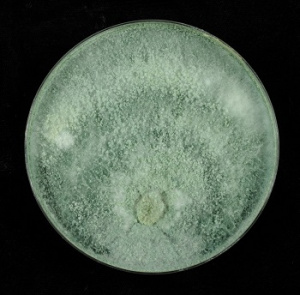For more information
Media Relations
Agriculture and Agri-Food Canada
1-866-345-7972
aafc.mediarelations-relationsmedias.aac@agr.gc.ca
The Okanagan Valley is home to one of the leading wine regions in Canada, but this success hasn’t come without a scuffle for British Columbia’s (B.C.) grape growers as they struggle to control a range of diseases in their vineyards every year. This includes the notoriously destructive grapevine trunk diseases (GTD).
GTD is a complex disease caused by various fungal pathogens that typically infect grapevine plants through pruning wounds. The fungi colonizes the vascular system of the plant, limiting its intake of water and nutrients and resulting in its eventual death. Since the fungi tends to move slowly, it can take a few years for growers to detect the infection and by then it’s often too late to treat it. Research from Dr. José Ramón Úrbez-Torres, a plant pathologist at Agriculture and Agri-Food Canada (AAFC), will help B.C. grape growers deliver a one-two punch to GTD with a number of sustainable practices to detect, prevent and treat this disease.
Taking (biological) control
One way to control this fungal issue is with, well, more fungi. Biological control is among the most sustainable and cost-effective options for handling various agricultural pest issues. This method involves introducing a pest’s natural enemy into an environment to aid in controlling populations, and Dr. Úrbez-Torres has found just the right candidates for this job. In laboratory, greenhouse and field trials at the Summerland Research and Development Centre, Dr. Úrbez-Torres and his team tested over 30 different strains of fungi belonging to the Trichoderma genus against GTD. Among these, a few were shown to be highly effective in controlling the disease. This work was conducted in collaboration with AAFC research affiliate Jinxz Pollard-Flamand while completing his Master of Science under the supervision of Dr. Úrbez-Torres and Dr. Miranda Hart, a professor at the University of British Columbia - Okanagan.
“The next step will be to develop a biological control product from these fungi, which will be the first of its kind against this disease in Canada.”
- Dr. José Ramón Úrbez-Torres, Research Scientist, Agriculture and Agri-Food Canada
Conveniently, these fungi are well-established in B.C., meaning a biological control product can be locally sourced and more easily accessible to growers throughout the province. As chemical fungicides continue to raise concerns due to pathogen resistance and toxicity to humans, animals and the environment, sustainable alternatives like this will prove beneficial.
A holistic approach offers fresh perspective
While biological control is just one way of preventing GTD, the complex nature of this disease calls for a more holistic approach. By studying which conditions favour the pathogen, Dr. Úrbez-Torres has found that pruning plants earlier than usual (example, in January rather than March) can reduce chances of infection by up to 80% in vineyards. Additionally, his team has developed instructions for growers to identify if their plants are infected, where to cut the vine to eliminate infection and how to form and retrain the new vine, a technique known as “remedial surgery”.
For what was once deemed an untreatable disease, this research offers growers options that give their grapevine plants a second chance in the vineyard. Growers can typically expect to see their grapevine plants return to production in about three to four years following practices such as remedial surgery, ultimately saving them from the laborious and expensive tasks of replanting.
“It's very difficult to fully eradicate the disease,” says Dr. Úrbez-Torres. “But our goal is to continue to share better management strategies with growers and help minimize the amount of plants they lose every year.”
Key Discoveries/Benefits:
- Dr. Úrbez-Torres has discovered several fungal species that are highly effective in the biological control of grapevine trunk diseases (GTD), which will be harnessed to develop Canada’s first biological control product against this disease complex, using locally sourced fungi.
- His team has also found that pruning plants earlier than usual can reduce chances of infection by up to 80% in vineyards.
- Additionally, his team has developed instructions that can help growers identify if their plants are infected, where to cut the vine to eliminate the infection and how to form and retrain the new vine.
- This research offers sustainable alternatives to chemical fungicides, which raise concerns related to pathogen resistance and toxicity to humans, animals and the environment.
Photo gallery

A canker in a grapevine plant caused by GTD

A dead cordon on a grapevine plant caused by GTD

Trichoderma canadense, a biological control fungi against GTD